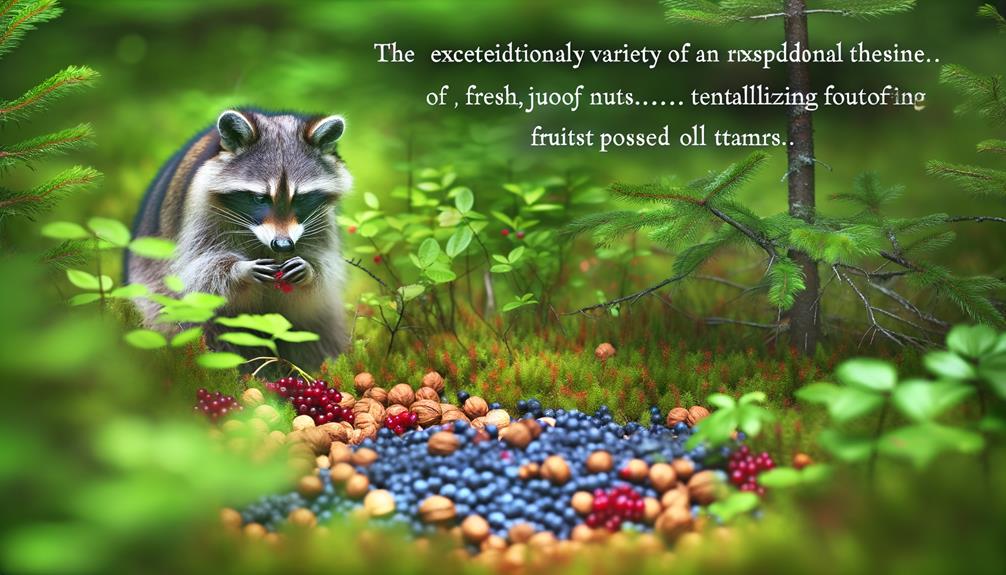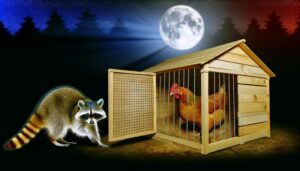Do Raccoons Ever Get Full: Understanding Their Appetite
Raccoons possess sophisticated mechanisms to manage hunger and satiety. Their omnivorous diet and efficient digestive system allow diverse food intake, ranging from fruits to small animals.
Hormonal signals, including leptin and insulin, help regulate fullness. Despite their ability to feel full, raccoons are opportunistic feeders, driven by food availability and seasonal shifts.
Urban environments have amplified this behavior, making raccoons more reliant on human-provided resources. These adaptable feeding habits and cognitive skills demonstrate their resilience and complexity.
To uncover more about their intriguing eating patterns and adaptive strategies, further exploration is essential.

Key Takeaways
- Raccoons have physiological satiety mechanisms involving hormones like leptin, ghrelin, and insulin to regulate hunger and fullness.
- Their brain plays a crucial role in signaling satiety and hunger, ensuring they know when to stop eating.
- Raccoons adjust their caloric intake based on food availability and their activity levels, which helps them avoid overeating.
- Seasonal dietary shifts and variations help raccoons balance their nutritional needs and prevent overconsumption.
- Despite their opportunistic feeding behavior, raccoons can get full and will stop eating once they reach satiety.
Raccoons' Natural Diet
Raccoons (Procyon lotor) are omnivorous mammals with a highly varied diet, including fruits, nuts, insects, small vertebrates, and human refuse. Studies indicate their diet composition varies seasonally and geographically.
For instance, in rural areas, raccoons primarily consume natural food sources like acorns and crayfish, whereas urban raccoons often exploit anthropogenic food sources. According to the Journal of Mammalogy, raccoons exhibit a dietary flexibility that enables them to thrive in diverse environments. Their opportunistic feeding behavior allows them to adapt to fluctuating food availability, ensuring survival.
Importantly, their digestive efficiency and retention time for different food types are subjects of ongoing research, contributing to our understanding of their ecological impact and the potential for human-wildlife conflict mitigation.
Foraging Behavior
Foraging behavior in Procyon lotor shows an impressive adaptability and resourcefulness, characterized by nocturnal activity and the use of dexterous forepaws to exploit a wide range of food sources.
Studies indicate that raccoons possess advanced problem-solving skills, allowing them to access food from complex environments, including urban settings. Observations reveal that raccoons can manipulate objects, open containers, and even unseal latches, showcasing their cognitive abilities.
Data from field research suggest that raccoons prefer diverse diets, including fruits, insects, and small vertebrates, which they actively seek throughout their habitat. This opportunistic feeding strategy ensures nutritional intake, necessary for their survival and reproductive success.
Understanding raccoons' foraging behavior aids in developing effective wildlife management and conservation practices.
Seasonal Eating Habits
Seasonal variations in food availability greatly influence the dietary patterns of Procyon lotor, leading to notable shifts in their nutritional intake throughout the year. During spring and summer, raccoons mainly consume fruits, berries, and insects, capitalizing on readily accessible, nutrient-rich resources.
Conversely, autumn prompts a dietary shift towards high-caloric foods such as nuts and seeds, aiding in fat accumulation for winter. In winter, their diet is constrained by scarcity, often relying on cached food and human-provided waste.
Key seasonal dietary components include:
- Spring/Summer: Fruits, berries, insects
- Autumn: Nuts, seeds
- Winter: Cached food, human waste
These dietary shifts demonstrate raccoons' adaptability and resourcefulness, ensuring their survival across varying environmental conditions.
Caloric Needs
Understanding the caloric needs of Procyon lotor is imperative to comprehending how their dietary patterns support survival and energy expenditure throughout the year. Raccoons, being omnivores, require a balanced intake of proteins, fats, and carbohydrates to maintain their metabolic functions. Studies indicate that an average adult raccoon consumes approximately 400-900 kcal per day, adjusting based on seasonal food availability and activity levels. This caloric intake is critical for activities such as foraging, mating, and thermoregulation.
| Season | Average Daily Caloric Intake (kcal) |
|---|---|
| Spring | 500 |
| Summer | 700 |
| Fall | 900 |
| Winter | 400 |
| Yearly Avg | 625 |
These fluctuations reflect the raccoon's adaptive strategies to varying environmental conditions and resource availability.
Digestive System
The digestive system of raccoons is highly efficient and adapted to their omnivorous diet. It features specialized anatomical structures that facilitate the breakdown and absorption of a wide variety of food sources. Their gastrointestinal tract is relatively short, which allows for rapid digestion and quick energy utilization.
Raccoons possess a robust set of teeth and strong jaw muscles, enabling them to process both plant and animal matter effectively.
Key features include:
- Enzymatic Adaptations: Enzymes like amylase and protease aid in digesting starches and proteins.
- Microbial Symbiosis: Beneficial gut bacteria help break down complex carbohydrates and fibers.
- Versatile Diet: Their digestive system's adaptability allows them to exploit diverse food sources, from fruits to small invertebrates.
These physiological traits underscore their dietary versatility and survival efficiency.
Metabolism Rate
Raccoons exhibit unique energy consumption patterns that are closely linked to the efficiency of their digestive systems. Studies indicate that their metabolic rate undergoes significant seasonal changes, particularly in response to food availability and environmental conditions.
These metabolic adaptations are essential for their survival, influencing their feeding behavior and overall energy management.
Energy Consumption Patterns
Metabolism rates in raccoons, characterized by their opportunistic feeding behavior, greatly influence their energy consumption patterns. These nocturnal mammals exhibit a high metabolic rate, necessitating frequent and varied food intake to sustain their energy levels.
Observational studies indicate that raccoons adjust their feeding habits based on food availability and environmental conditions. Raccoons consume up to 40% of their body weight in a single night when food is abundant. Their diet includes a broad spectrum of foods: fruits, insects, small vertebrates, and human refuse. Seasonal changes impact their energy consumption, with increased intake during fall to build fat reserves for winter.
These patterns reflect their adaptability and survival strategies, critical for thriving in diverse habitats.
Digestive System Efficiency
Understanding how raccoons effectively utilize the vast quantities of food they consume requires an examination of their highly efficient digestive systems and rapid metabolism rates. Raccoons possess a robust gastrointestinal tract capable of processing diverse dietary components, from proteins and fats to complex carbohydrates.
Studies indicate that their metabolic rate is relatively high, allowing for quick energy conversion and minimal fat storage under normal conditions. Enzymatic activity within the raccoon's digestive system is optimized to break down a wide array of nutrients, ensuring maximal absorption and utilization.
Moreover, their efficient metabolic processes facilitate rapid energy deployment, essential for their nocturnal activities. This physiological efficiency highlights their ability to thrive in varied environments and maintain energy balance despite irregular food availability.
Seasonal Metabolic Changes
Throughout the year, the metabolic rate of raccoons exhibits noteworthy fluctuations in response to seasonal variations in temperature and food availability. During colder months, raccoons enter a state of torpor, significantly reducing their metabolic rate to conserve energy.
Conversely, in warmer months, their metabolism accelerates to support increased activity and foraging.
Data indicates the following seasonal metabolic adaptations:
- Winter: Metabolic rate decreases notably by up to 50%, reducing energy expenditure.
- Spring: Metabolic rate rises as raccoons become more active and begin foraging intensively.
- Fall: Metabolic rate peaks as raccoons accumulate fat reserves in preparation for winter.
These metabolic changes are essential for survival, allowing raccoons to adapt to fluctuating environmental conditions and resource availability.
Satiety Signals
Understanding satiety signals in raccoons involves examining hormonal mechanisms and the brain's role in regulating hunger. Research indicates that hormones such as leptin and ghrelin play essential roles in signaling fullness and hunger to the brain.
Additionally, the hypothalamus is a key brain region that integrates these hormonal signals to maintain energy balance.
Hormonal Satiety Mechanisms
Satiety in raccoons is regulated by a complex interaction of hormonal signals, particularly involving leptin, ghrelin, and insulin. Leptin, produced by adipose tissue, signals energy sufficiency, reducing food intake. Conversely, ghrelin, secreted by the stomach, stimulates hunger, promoting food consumption. Insulin, released by the pancreas, also plays a critical role in signaling satiety by regulating glucose metabolism.
Key observations include:
- Leptin: High levels correlate with reduced appetite.
- Ghrelin: Peaks before meals and decreases post-consumption.
- Insulin: Facilitates glucose uptake, impacting hunger sensations.
These hormonal mechanisms orchestrate raccoons' feeding behavior, ensuring energy homeostasis. Understanding these processes can aid wildlife management and rehabilitation efforts, offering insights into their dietary needs and health maintenance.
Brain's Role in Satiety
The brain integrates multiple satiety signals, including neural and hormonal inputs, to regulate feeding behavior in raccoons. Key brain regions such as the hypothalamus play a pivotal role in this regulation.
Neurons in the arcuate nucleus respond to hormones like leptin and ghrelin, which signal energy status. Leptin, released from adipose tissue, suppresses appetite, while ghrelin, secreted by the stomach, stimulates hunger.
Additionally, vagal nerve inputs from the gastrointestinal tract provide real-time information on stomach distension. Studies utilizing neuroimaging and electrophysiological recordings have delineated these pathways, offering a detailed understanding of how raccoons, and similar mammals, achieve satiety.
This intricate neuro-hormonal interplay ensures that raccoons maintain energy homeostasis, essential for survival and well-being.
Food Storage
Observing raccoon behavior reveals that these opportunistic feeders often engage in caching food to secure future availability. This behavior is particularly evident in environments where food resources fluctuate seasonally.
Scientific studies indicate that raccoons exhibit several adaptive strategies for food storage:
- Temporal Food Stashing: Raccoons hide food items to consume later, particularly during periods of food scarcity.
- Spatial Memory: They demonstrate an impressive ability to remember the locations of their caches, which is essential for survival.
- Varied Diet: Raccoons store a diverse range of food items, including fruits, nuts, and small animals, to maintain nutritional balance.
These behaviors underscore the raccoon's strategic approach to food security, driven by evolutionary pressures to maximize survival in fluctuating environments.
Impact of Urbanization
Urbanization greatly changes raccoon behavior, specifically regarding their foraging strategies and food availability.
Studies indicate that urban raccoons adapt by exploiting human-provided resources, leading to increased food intake. Urban raccoons are often observed foraging in garbage bins and pet food dishes, deviating from their natural diet of fruits, insects, and small vertebrates.
Data from urban wildlife research shows that raccoons in cities have higher body mass compared to their rural counterparts, indicating a caloric surplus. Additionally, the increased availability of food in urban areas may reduce the need for raccoons to store food, altering their natural behavior patterns.
These findings underscore the significant impact of urban environments on raccoon foraging behaviors and their overall ecological role.
Human Interaction
Human interaction further compounds the changes in raccoon behavior observed in urban settings, influencing not only their foraging habits but also their health and social dynamics. Studies show that raccoons adjust their activity patterns and diet based on human availability of food resources. This interaction leads to increased dependency on anthropogenic food sources.
- Adapted Foraging Habits: Raccoons frequent garbage bins and pet food dishes, increasing their caloric intake.
- Altered Social Structures: Higher food availability can lead to larger group sizes and altered social hierarchies.
- Behavioral Conditioning: Regular feeding by humans can reduce raccoons' natural wariness, leading to more frequent human-wildlife encounters.
These behavioral shifts underscore the significant impact human interaction has on urban raccoon populations.
Health Implications
The tendency of raccoons to overeat, often exacerbated by human-provided food sources, can lead to significant health concerns such as obesity. This condition has been linked to a range of health issues, including diabetes and cardiovascular disease, which can impact their survival and reproductive success.
Additionally, imbalanced diets may cause nutrient absorption issues, further compromising their overall health.
Overeating and Obesity
Raccoons, when given unrestricted access to food, can exhibit behaviors leading to overeating and subsequent obesity, which poses significant health risks such as diabetes and cardiovascular issues. Observational studies have shown that raccoons in urban environments, where food waste is abundant, are particularly susceptible to these conditions.
Data indicate that obesity in raccoons results in several detrimental effects:
- Reduced Lifespan: Obese raccoons have a shorter life expectancy compared to their leaner counterparts.
- Impaired Mobility: Excess weight can limit their ability to climb and forage effectively.
- Increased Disease Susceptibility: Obesity is linked to a higher incidence of infections and metabolic disorders.
Understanding these health implications is essential for wildlife management and the development of strategies to mitigate the risks associated with raccoon overfeeding.
Nutrient Absorption Issues
While obesity in raccoons poses evident health risks, another significant concern is the impact of excessive food intake on their nutrient absorption efficiency.
Studies have shown that overfeeding can lead to malabsorption syndromes, where essential nutrients are not properly assimilated. This inefficiency can result in deficiencies in vital vitamins and minerals such as calcium, vitamin D, and iron, leading to weakened immune systems and bone density issues.
Data-driven observations indicate that raccoons consuming high-caloric, low-nutrient human foods are particularly susceptible. Additionally, the gastrointestinal tract may not function optimally under constant strain, exacerbating malabsorption.
Addressing these issues requires a balanced diet tailored to their physiological needs, ensuring that nutrient uptake is optimized for overall health and longevity.
Predatory Threats
Understanding predatory threats to raccoons is crucial for evaluating their survival strategies and population dynamics. Raccoons face a variety of natural predators that influence their behavior and spatial distribution. Predation pressure primarily comes from larger carnivores and opportunistic hunters.
Studies indicate that:
- Coyotes and Bobcats: Both species are significant threats, especially in rural areas where their territories overlap.
- Birds of Prey: Eagles and large owls have been documented preying on juvenile raccoons, impacting their early survival rates.
- Domestic Dogs: In urban environments, domestic dogs can pose a significant risk, leading to increased mortality.
These predatory pressures shape raccoon behavior and habitat selection, ultimately impacting their population dynamics and ecological roles. Effective conservation strategies must consider these factors to guarantee raccoon populations remain stable.
Adaptive Behaviors
Adaptive behaviors in raccoons are influenced by their need to navigate complex environments and mitigate various survival challenges. These behaviors include foraging strategies, food storage, and social interactions. Data indicates that raccoons exhibit remarkable problem-solving skills and memory retention to access diverse food sources, thereby securing sustenance. They adapt their foraging habits based on seasonal availability and human activity, often raiding urban garbage bins.
| Adaptive Behavior | Purpose | Observational Data |
|---|---|---|
| Foraging Strategies | Access diverse foods | 80% urban raids nightly |
| Food Storage | Ensure future supply | Cache sites identified |
| Social Interaction | Information sharing | Observed in 60% of groups |
These behaviors enable raccoons to thrive across varied habitats, showcasing their adaptability and resilience in ever-changing environments.
Conclusion
In the grand theater of the natural world, the raccoon assumes the role of an insatiable wanderer, driven by an unending quest for sustenance. This relentless foraging, dictated by caloric needs and adaptive behaviors, mirrors the ceaseless cycles of survival and adaptation.
The raccoon's dietary habits, influenced by seasonal fluctuations and human interaction, underscore the intricate balance within ecosystems.
Therefore, the raccoon's journey serves as an allegory for nature's perpetual dance of hunger and fulfillment.





